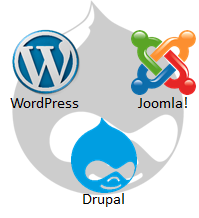
The term “Web 2.0”refers to evolved web techniques such as these provide a (better) interaction between users and sites, allowing the former to not only reading the web-content but also writing into and providing additional contributions. CMS (Content Management System) are intended to easily issue this kind of features, simplifying the mode of web-interaction between writers and sites. In fact, it allows for websites based on contents/comments paradigm, dis-coupling content (the inserted stuff) from the readable HTML page (the showing shape). Usually, the CMS are modular systems, in which additional software modules could be installed, allowing user to insert different type of contributions (e.g. text comments and corrections, images, business transactions, etc). On the basis of these different site types could be created, like: Blog, Community (Forum, Photo-Gallery), Magazine (Article), Encyclopaedia (Wiki), Portal (Multi-Site, Multi-Language), Shop (e-Commerce), etc. Actually, it is not possible to conceive Internet without Web2.0, that is, without CMS. In fact, CMS allows for “live” websites, always updated (taking advantage of ease of web-publishing) and continuosly fed back (capitalize on visitors' experience). But Web 2.0 sites could get broken because both inability or fraud.This book is about the resilience of CMS, in term of:
-
CMS Projecting: approach the building of a Web 2.0 site thoroughly, facing the intricacy of CMS and the dullness of its model, smartly. Each phase of Web 2.0 lifecycle is important: Plan, Develop, Deploy, Maintain and Dismiss
-
CMS Securing: protect from cyber-attacks and safeguard information, using Drupal as it seems to be the most secure CMS. As stated by [10] the most CMS make use of PHP as server application processing and MySQL as DB system. CMS Security starts protecting both
Mastering the concepts explained, the Web 2.0 resilience get from a complex matter (unpredictable with emergent behaviours) to a bit complicated one (full modelized and well understood). The proposed approach make the initial difficulty to understand and modelize CMS to turn into a dull task, enhancing the ability of implementing new capabilities for managing content and providing efficient security protection of information.
Nowadays Web 2.0 are extremely powerful, offering a large amount of different features and requesting for new ones, continously. It could be accomplished only by the means of a highly structured CMS product. However, Drupal is the only Open-Source product that takes Security issues into deep consideration, allowing, in the meantime, for a complete framework of CMS capabilities.
